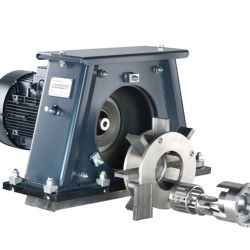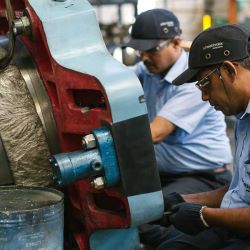Mexican foundry Tisamatic has benefitted from a significant reduction in downtime at their new facility in San Luis Potosi after upgrading one of their existing blast machines with new Wheelabrator components.
A subsidiary of the Grupo Industrial Saltillio (GIS) conglomerate, Tisamatic produces high-precision grey and ductile iron castings for the automotive industry, including engine blocks and parts for drivetrains, brakes and chassis systems. The company opened a second foundry in San Luis Potosi in the summer of 2014 following a $65 million investment. The new plant has the capacity to produce 120,000t each year and is focussed on exporting castings to automakers in North and South America, as well as Europe and Asia.
Tisamatic has three identical tumblast machines from Wheelabrator, which are crucial to the operation and are mainly used to clean drive shafts and brake discs. An ambition to ramp up production prompted Tisamatic to contact Wheelabrator Plus to analyse the performance of one of the three machines, to ensure blast operations would cope with increased output targets.
The 30-year-old machines’ performance had dipped, with high abrasive consumption and large amounts of sand in the operating mix causing high wear and consequently a lot of unplanned downtime. The Wheelabrator team recommended an Equipment Modernisation Programme (EMP) to address these issues and improve the machine’s productivity. An assessment showed that upgrading the two blast wheels to a dual 50HP EZEFIT wheel arrangement (EZEFIT wheels are the imperial equivalent to our metric SATURN wheels) and installing new magnetic separators would bring significant benefits. A new, larger upper screw conveyor and rotary screen were also installed to significantly improve the condition of the abrasive mix. The combined result of the improved abrasive screening and powerful wheel arrangement: the amount of sand in the operating mix has been reduced by almost 70%, and the machine can handle higher abrasive throughputs without excessive abrasive breakdown or wear inside the machine.
Since the upgrade, maintenance time for the machine is down, with machine availability up by 60%. Cycle time has been reduced by almost a fifth, creating headroom in production capacity for Tisamatic.
Roberto Martínez Guerra, Maintenance Manager at Tisamatic said: “We’re very pleased with the new heights of performance our trusted old blast machine has scaled since the upgrade. The improved cycle time and increased machine availability help us meet higher output targets. At the same time, we’re no longer wasting abrasive or losing hours on unnecessary downtime.”
Enrique Martínez Bautista, Maintenance Supervisor at Tisamatic added: “Purchasing a new machine was not a feasible option – due to the disruption to production and space restrictions. Giving our 30-year-old machine a new lease of life was the perfect solution - at a much lower cost. We can now move ahead with our plans to increase production and we will be looking at implementing a similar upgrade for our other two machines.”
Ivan Gomez, Sales Engineer at Wheelabrator Plus, commented: “Our Equipment Modernisation Programmes can be a very cost-effective and time-efficient alternative to purchasing a new machine. There’s a lot we can do to bring an old machine up to date – or even modify it for new applications and requirements. We’ve invested heavily in the development of new components, particularly for heavy-duty environments. New HD rotary screens, for example, can make a huge difference in foundry blast operations, where a clean abrasive operating mix is threatened by contamination with sand, which causes a whole range of performance issues. The project with Tisamatic shows the step-change an EMP can effect. We’re thrilled at the results they’re getting thanks to the upgrade.”


